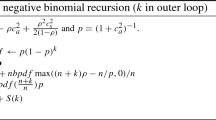Abstract
An equation for the distribution Z(⋅) of the duration T of the busy period in a stationary M/GI/∞ service system is constructed from first principles. Two scenarios are examined, being distinguished by the half-plane Re(θ)>θ0 for some θ0≤0 in which the generic service time random variable S, always assumed to have a finite mean E(S), has an analytic Laplace–Stieltjes transform E(e−θS). If θ0<0 then E(e−θT) is analytic in a half-plane (θ1,∞), where θ0≤θ1<0 and θ1 is determined by the distribution of S; then \(\bar Z(x) \equiv \Pr \{ T >x\} = {\text{o(e}}^{--sx} )\) for any 0<s<|θ1|.
When θ0=0, E(e−θT) is analytic in (0,∞), and now more is known about T. Inequalities on the tail \(\bar Z\)(⋅) are used to show that for any α≥1, E(T α) is finite if and only if E(S α) is finite. It follows that the point process consisting of the starting epochs of busy periods is long range dependent if and only if E(S 2)=∞, in which case it has Hurst index equal to [frac12](3−κ), where κ is the moment index of S.
If also the tail \(\bar B\)(x)=Pr{S≥x} of the service time distribution satisfies the subexponential density condition ∫0 x \(\bar B\)(x−u) \(\bar B\)(u) du/ \(\bar B\)(x)→2E(S) as x→∞, then \(\bar Z\)(x)/\(\bar B\)(x)→eλE(S), where λ is the arrival rate.
Similar content being viewed by others
References
N.H. Bingham, C.M. Goldie and J.L. Teugels, Regular Variation (Cambridge Univ. Press, Cambridge, 1987).
D.J. Daley, The Hurst index of long range dependent renewal processes, Ann. Probab. 27 (1999) 2035-2041.
D.J. Daley, Subexponential probability density functions, Manuscript (2000).
D.J. Daley and R. Vesilo, Long range dependence of inputs and outputs of classical queues, in: Analysis of Communication Networks, eds. D.R. McDonald and S.R.E. Turner, Fields Institute Communications, Vol. 28 (2000) pp. 179-186.
P. Hall, Introduction to the Theory of Coverage Processes (Wiley, New York, 1988).
C. Klüppelberg, Subexponential distributions and integrated tails, J. Appl. Probab. 25 (1988) 132-141.
V.G. Kulkarni, Modeling and Analysis of Stochastic Systems (Chapman and Hall, Boca Raton, FL, 1996).
M. Loève, Probability Theory, 2nd edn. (Van Nostrand, Princeton, 1960) (4th edition published by Springer).
P.A.P. Moran, An Introduction to Probability Theory (Clarendon Press, Oxford, 1968).
K.B. Athreya and P.E. Ney, Branching Processes (Springer, New York, 1972).
Author information
Authors and Affiliations
Rights and permissions
About this article
Cite this article
Daley, D. The Busy Period of the M/GI/∞ Queue. Queueing Systems 38, 195–204 (2001). https://doi.org/10.1023/A:1010958415137
Issue Date:
DOI: https://doi.org/10.1023/A:1010958415137



